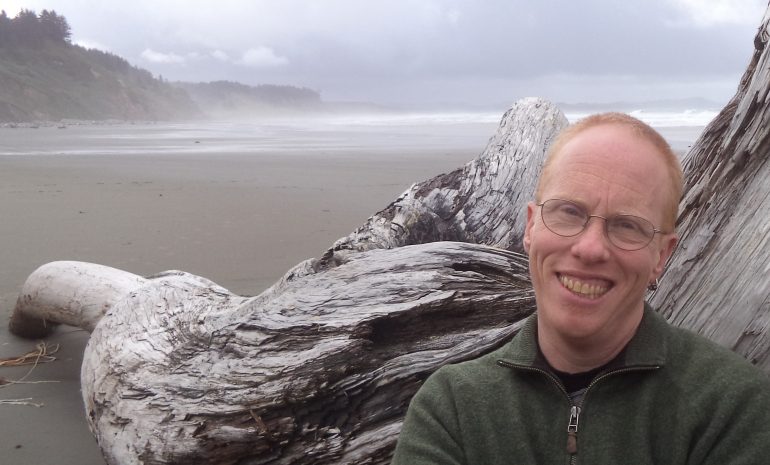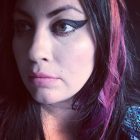The Complicated and Contradictory Mosaic of Cure: An Interview with Eli Clare

Image: Author Eli Clare (Samuel Lurie)
Eli Clare set out to write about cure more than a decade ago, imagining “a simple, well-laid out collage . . .” There is, of course, nothing simple about cure. As Clare notes,
“The American Heritage Dictionary defines cure as the ‘restoration of health.’ . . . for some of us, even if we accept disability as harm to individual bodies, restoration still doesn’t make sense, because an original non-disabled body doesn’t exist. How would I, or the medical establishment, go about restoring my body? The vision of me without tremoring hands and slurred speech, with more balance and coordination, doesn’t originate from my body’s history. Rather it arises from an imagination of what my body should be like, some definition of normal and natural.
Clare’s collage, found in his new collection Brilliant Imperfection: Grappling with Cure, became a “mosaic . . . (of) fragments and slivers.” For Clare—genderqueer, white, disabled from birth—the concept of cure is laden with personal history. But Clare’s lens is broader. In cure, he finds a concept deeply embedded in cultural systems, in perceptions of disease, difference, abnormality: what he terms “trouble.” This trouble, like any trouble, doesn’t exist independently of the framework that surrounds it: diagnosis, treatment, management, rehabilitation, and prevention.
Clare’s writing is radical in its refusal to condense to a prescriptive right or wrong without ever sliding into passivity. His book, The Marrow’s Telling: Words in Motion, was a 2008 Lambda Literary Award finalist. His 1999 essay collection, Exile and Pride: Disability, Queerness, and Liberation, was reissued in a third edition by Duke University Press in 2015. Exile and Pride contains poetry in its margins, epigraph-like, between passages of personal history, academic prose, and carefully footnoted research. Brilliant Imperfections goes even further with this insistence on writing in not one genre, but all, the kind of writing that harkens back a few hundred years into the past, or a future in which genres and genders are neither fixed nor fragile. And then there are passages of “Brilliant Imperfection” that shimmer and spark, images that remain embedded in the reader’s attention throughout the essays within which they’re contained.
Brilliant Imperfections are designed to characterize a “fractured wholeness” that “resists the pressures of normal and abnormal . . . (of) natural and unnatural.” In our interview, Clare said, “It would be easy to link my genre-crossing writing to my life as a genderqueer who spent years being called ma’am on one street corner and sir on the next, who grew up a tomboy girl and is now recognized as a white guy in the world. Easy to make an analogy between gender-crossing and genre-crossing. But I suspect my hard-to-categorize writing has less to do with who I am and more to do with the nature of categories, which, whether they be gendered boxes, genre designations, or the scientific classification of species, can be useful in countless ways. But for every category there is something or someone hanging out on the borders.”
We held our conversation by e-mail as Clare traveled for three days by train, and I sat in my small home in the southern Appalachians.
Carolyn Ogburn: Do you think of your blend of poetry and prose as a form or a structure? And how does this blend mirror your sense of yourself—if, in fact, it does?
Eli Clare: I don’t think of the ways I combine genres as either form or structure. Rather, as poet who came to prose after fifteen years of writing poems, I’m always paying attention to words, to sound and rhythm, to images and metaphors, as well as ideas and arguments. Sometimes what I’m writing needs a snippet of personal story grounded in specific details, and other times a broader sweep of history; sometimes I’m drawn to the spareness of poetry and the ways line breaks can insert ambiguity and complexity into a train of thought, and other times I need the sprawling room that an essay provides.
I came of age as a poet and an activist in the mid-1980s reading and studying lesbian feminist writers—Audre Lorde, Adrienne Rich, Gloria Anzaldúa, Beth Brant, Cherríe Moraga, Judy Grahn, Paula Gunn Allen, and Pat Parker to name a few—who combined genres with abandon, insisted on the personal and the political, and knew race, class, gender, sexuality, imperialism, and capitalism to be deeply intertwined. Their work resisted so many constraints and borders. My work is indebted to these writers, many of them women of color.
CO: How did you come to name these short pieces “Brilliant Imperfections” and how are they meant to relate to the larger work?
EC: As I wrote the book, I wanted to keep the notion of Brilliant Imperfection fluid and flexible, to let it live in experiences rather than definitions. And so I set out to write a dozen or so prose poems about moments of Brilliant Imperfection in my life—ambiguous moments that defy common or simple understandings, refuse both beauty and perfection, and exist in stark contrast to cure—the ideology which tells us that what is broken must be repaired. As the book started to come together, these prose poems became pivots, or maybe punctuation—places to pause; catch one’s breath; transition from one idea, history, or story to another.
CO: One of the questions I think many artists and writers are struggling with in the post-election political climate is what is the role of art right now; that is, if we find ourselves politically opposed to the politics of xenophobia, racism, nationalism, and corporate interests, how should we, as artists, respond? If body-mind cannot be considered separate, can art be separate from social-political discourse? Is there room for ambiguity in a time so dominated by ableism?
EC: As a writer-activist, I’ve long understood all art to be political, either explicitly or implicitly, consciously or unconsciously. Right now, during this political moment when Trump and the Republicans are dismantling the Affordable Care Act, ICE is detaining Migrant Justice leaders in Vermont, and the new head of the EPA is denying the role of carbon dioxide in global warming; artists and writers need to be part of the resistance. We need to take to the streets, call our legislators, tell the truth in all the ways truth can be told, imagine the multitude of things both liberation and repression can mean, unleash desire and community, and know our work has the potential to save lives.
This is not a time for ambiguity about racism, xenophobia, Islamophobia, anti-semitism, transphobia, ableism, sexism, homophobia, capitalism, and imperialism, and how they are twined together. People are dying, and will die, because of these systems and the ways they’re playing out under Trump’s administration. At the same time, to find liberation, we need body-mind politics as complicated and contradictory as our body-minds themselves. Brilliant Imperfection is reaching toward these politics.
CO: I love the way you connect the ideas we have about the “natural world” (which is, of course, a landscape constructed by multiple forces) and the idea of “normal,” particularly as it pertains to disability.
EC: Disability, the natural world, environmental destruction, and living rurally are connected in so many ways. I think of migrant farm work and the largely rural labor of resource extraction (logging, fishing, oil drilling, coal mining, etc.) as locations of both disability and environmental damage. I think of the ways poverty and lack of access to health care magnify these locations. I think about how clean air and living rurally provides access and refuge for people with environmental illness and multiple chemical sensitivities. I think of how nonsensical the white Western concepts of natural and unnatural, normal and abnormal can be. In Brilliant Imperfection I write: “The medical-industrial complex pushes normal weight, normal walking, normal ways of thinking, feeling, and communicating as if normal were a goal to achieve and maintain. Sometimes normal is attached to natural; multi-national corporations marketing natural beauty, natural strength, natural skin every day, as if natural were a product to sell.”
At the same time, white Western beliefs separate human animals from non-human nature and devalue the natural world. Coupled with capitalism, these beliefs drive an out-of-control greed for and consumption of coal and trees, fish and crude oil, water and land. Drive the destruction of what is natural. . . . In short, the white Western world both desires to be natural and destroys what is natural, depending on the context. It makes no sense.
There’s a growing body of writing and art about these connections. See, for instance:
- Laura Hershey’s writing about her experiences at Yosemite National Park
- Leah Lakshmi Piepzna-Samarasinha’s poem, “Dirty River,” that’s in part about the connections between poverty, chronic illness, and environmental pollution
- Sunaura Taylor’s Beasts of Burden about disability and animal liberation.
On the academic side, check out:
- Alison Kafer’s Feminist, Queer, Crip
- Mel Chen’s Animacies
- The brand new anthology Disability Studies and Environmental Humanities



